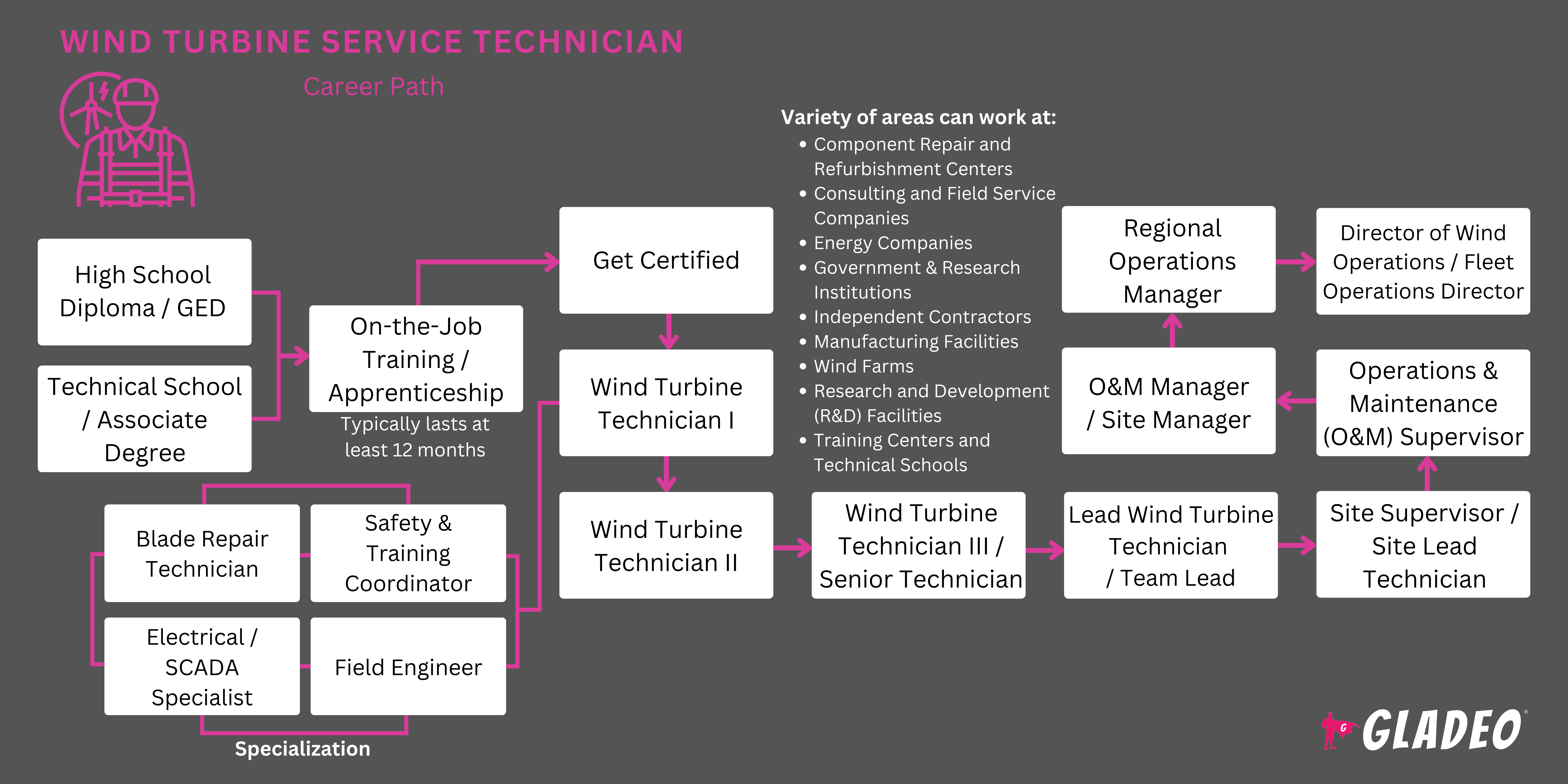Spotlights
Field Service Technician, Renewable Energy Technician, Service Technician, Troubleshooting Technician, Wind Farm Support Specialist, Wind Technician, Wind Turbine Operator, Wind Turbine Service Technician, Wind Turbine Technician, Wind Turbine Troubleshooting Technician
As corporations and governments continue to search for renewable energy sources, they keep coming back to wind power. Wind is clean, cost-effective, sustainable, and turbine towers can be incorporated into many existing rural sites. Wind Turbine Service Technicians, though still relatively small in number, are a crucial part of a much larger industry expected to grow in the coming years.
Also called Windtechs, workers in this field are responsible for installing, maintaining, and repairing massive turbines which can reach as high as 380’ from the ground to the tip of a rotor blade. Most Wind Turbine Service Technicians are involved with lubricating parts, performing inspections, and the upkeep of electricity-generating equipment housed inside nacelles. Windtechs drive out to worksites for regularly scheduled maintenance duties, but they also respond to performance problems that can be detected remotely via electronic monitoring.
To gain access to the equipment they need to work on, Windtechs must ascend ladders within the towers, then come out on top where they may be exposed to wind and other elements. Meanwhile, rappelling down ropes is necessary to work on blades. Clearly, those with a fear of heights will not want to work in this profession!
- Working in an environmentally-friendly sector
- Potentially saving clients money through efficient use of renewable energy
- Gaining experience in an established sector that still has plenty of room to grow
Working Schedule
- Although there are countless wind turbines in the US, the Bureau of Labor Statistics reports a relatively low number of workers. Without more Windtechs, there will be a shortage, and currently-trained employees may be asked to do more. Work is full-time but requires a considerable amount of travel to get to often remote locations. In emergencies, Wind Turbine Service Technicians may be called to respond during irregular hours.
Typical Duties
- Inspecting tower exteriors and fiberglass blades for wear or damage
- Using safety harnesses to climb internal tower ladders to the work area
- Troubleshooting issues with nacelle electronics, mechanical parts, and hydraulics
- Performing maintenance and repairs
- Gathering test data and testing various components and systems
- Replacing worn or malfunctioning parts
- Working in substations, on fiber optic sensing, or transitions systems
- Testing electrical components using a variety of tools
- Starting generator systems
Additional Responsibilities
- Reviewing video footage provided by drone pilots as part of inspections
- Collect data, maintain records of tests and maintenance
- Manage parts and tools inventory
Soft Skills
- Analytical
- Commitment to quality assurance
- Dependable
- Detail-oriented
- Focus
- Honesty
- Independent
- Safety-minded
- Sound judgment and reasoning
- Strong communication skills
- Teamwork
- Troubleshooting skills
Technical Skills
- Comfortable working at elevated heights
- Dexterity
- Mechanical skills
- First aid/CPR
- Normal (or correctable) vision
- Familiarity with personal protective equipment
- Physical strength and stamina to climb ladders and rappel
- Steady hands and arms; good hand-eye coordination
- Email and spreadsheets
- Knowledge of electrical, braking, and mechanical systems
- Hydraulic maintenance
- Computers and programmable logic control systems
- Enterprise resource planning software
- Computerized maintenance management system (CMMS)
- Industrial control software - SCADA software, Vestas Remote Panel
- Electric power generation sites
- Utility system construction sector
- Repair and maintenance service providers
- Research and development
- Self-employed business owners
If you’re looking for office work, this job isn’t for you! The average Wind Turbine Service Technician spends much of their day working at extreme heights, with one other person. Climbing up tall tower ladders or rappelling down ropes is physically demanding and obviously dangerous. Some work demands being cramped inside confined space areas, while other parts of the job expose them to the sun, wind, and other elements as they work outside on blades or other areas.
Sites are often in remote rural areas, requiring long commutes. Windtechs usually work on regular schedules, but can be called at any time if there’s an urgent need to repair a non-functioning turbine. The longer a turbine is down unexpectedly, the more money is lost, so Wind Turbine Service Technicians are expected to hustle while maintaining all safety protocols and doing the job to the best of their abilities each time they go out.
BLS predicts an eye-popping 57% rise in jobs for Windtechs, which vastly outperforms the average of most sectors. That said, remember that this is such a small field to begin with that 57% only adds up to ~3,800 jobs in the next decade. Still, many people shy away at the thought of working hundreds of feet in the air, and that single factor filters out most potential competition. Towers are only getting taller, allowing for bigger blades and more cost-efficient power generation...an important consideration when dealing with renewable energy options.
Those interested in becoming Windtechs should closely review opportunities in the state they wish to live and work in. For various reasons, turbines are more prevalent in some states than others. Some states, for instance, have more rural areas, experience windier conditions, or are simply more politically inclined to pursue wind power options. Per BLS, the states with the highest employment for Windtechs are Texas, Minnesota, California, Iowa, and Oklahoma. However, the states with the highest concentration are Wyoming, South Dakota, Iowa, North Dakota, and Oklahoma. Offshore wind research and development projects are other options being funded and requiring qualified workers.
As mentioned, being a Wind Turbine Service Tech requires physical strength, the ability to work at great heights, and a lot of working outdoors and driving to remote sites. People who are drawn to this field most likely enjoyed sports, hiking, rock climbing, or just being outside as much as possible. Windtechs typically work with a partner for safety reasons, however much of their job requires actually performing the work on their own. Thus they were probably very comfortable being by themselves as kids, or at least just as content to be alone as with other people.
They were probably math wizards or liked tinkering on electronic gadgets when they weren’t outside. In fact, many probably enjoyed working with tools in a home garage with the door up so they could get sunlight and fresh air as they tinkered on their projects. Some workers may also have been environmentally-conscious and interested in a career that helps develop alternative energies. Energetic, dependable, and practical, Windtechs maintain a unique balance of skill sets that can be tough to beat.
- A four-year college degree is not required for this profession
- Per On-Net, Wind Turbine Service Techs are high school grads, with 36% holding a post-secondary certificate and 19% an associate's (certificates or an associate’s will make you more competitive when looking for jobs)
- Associate degrees are typically in wind energy technology
- Certificates can include electrical safety, tower climbing, and self-rescue
- ETA International offers a stand-alone Small Wind Installer - Level 1 advanced cert
- Coursework may include electrical, braking, and mechanical systems; hydraulic maintenance; programmable logic control systems; enterprise resource planning software; CMMS; and industrial control software
- Supplementary coursework includes first aid/CPR and safety topics
- Windtechs undergo up to a year or more of OJT, to include manufacturer-specific training
- Some workers intern with a contracted service provider
- A career as a Wind Turbine Service Technician requires physical and mental preparedness
- Classes involving athletics, labor, tool usage, and safety will help develop necessary physical aspects, while math, electronics, and IT coursework can build tech skills
- High school students might be able to knock out community college/vocational training and get a head-start on their future Windtech careers
- As a small field, it should be easy to find internship opportunities on Indeed.com, or by contacting local companies directly
- Gain practical labor experience through part-time jobs that require safety training or working in elevated or confined space environments
- Review Skills Needed on the Job above for a list of programs to get familiar with
- Check out free online classes such as Alison’s Wind Energy - From Wind Turbines to Grid Integration
- Watch related videos on YouTube or enroll in paid offerings like Udemy’s Wind Energy Fundamentals: Renewable Energy Power Course
- Read professional organization blogs and articles (see Recommended Resources in Landing the Job tab)

- Because of the growing demand for Wind Turbine Service Technicians, the outlook is very good for those with the right balance of skills and training
- Use Glassdoor, Indeed, and other popular job portals to find openings; sign up for alerts to get a notification of new postings
- Some local companies might also advertise on Craigslist
- Ask your college or vocational training center if they can assist with job hunting. Many have existing connections with companies who are ready to recruit successful students
- Before you type up a resume, get ideas from online Windtech resume templates
- Focus on relevant work and academic experiences, skills, and personal characteristics
- Expect employers to peek at your social media and other public profiles
- Sometimes workers post their interview experiences online, such as at Glassdoor. Check out what they have to say and learn from their advice!
- U.S. News ranked Windtech as the #5 Highest Paying Job Without a Degree and #2 in Best Maintenance and Repair Job
- The more education and training you have when you start out, the faster you’ll be able to finish your OJT
- Become proficient as soon as possible, and demonstrate consistency and reliability
- Learn manufacturer-specific procedures inside and out
- Obtain professional certifications and become a trusted asset with your company
- Use your driving time wisely. When commuting out to a worksite, talk shop and ask questions
- Talk with your supervisor about promotion to ensure you have a clear understanding of expectations, requirements, and available opportunities
- Be realistic; there may be long waits for promotion opportunities in some small businesses
- Remember, 13% of workers are listed as self-employed!
Websites
- American Wind Energy Association
- Department of Energy, Office of Energy Efficiency & Renewable Energy
- Energy.gov
- ETA International
- Interstate Renewable Energy Council
- Interstate Renewable Energy Council Solar Licensing Database
- IRENA
- North American Board of Certified Energy Practitioners
- U.S. Energy Information Administration
- Wind Energy Technologies Office
- WINDExchange
- Windustry
Books
Seriously, the fear of heights is a major reason why many people are not suitable for this field. The Bureau of Labor Statistics lists plenty of related occupations, most of which don’t require a four-year degree to get started:
- Electrical and Electronics Installers and Repairers
- Electricians
- Elevator Installers and Repairers
- Heating, Air Conditioning, and Refrigeration Mechanics
- Industrial Machinery Mechanics
- Machinery Maintenance Workers
- Millwrights
- Plumbers, Pipefitters, and Steamfitters
Newsfeed

Featured Jobs

Online Courses and Tools

Annual Salary Expectations
New workers start around $67K. Median pay is $87K per year. Highly experienced workers can earn around $107K.





